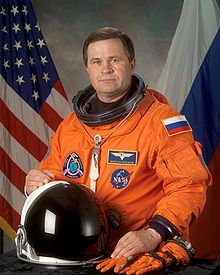Nikolai Budarin
Russian - (RFSA)
Retired
Date of Birth: April 29, 1963
Age: 62
Nikolai Mikhailovich Budarin (Russian: Николай Михайлович Бударин) (born April 29, 1953 in Kirya, Chuvashia) is a retired Russian cosmonaut, a veteran of three extended space missions aboard the Mir Space Station and the International Space Station. He has also performed eight career spacewalks with a total time of 44 hours. Named a cosmonaut candidate in 1989, Budarin's first space mission was a long-term assignment aboard the space station Mir in 1995. Since then, he again made extended stays on Mir in 1998 and the International Space Station Expedition 6 from 2002 to 2003.
Soyuz-U2 | Soyuz TM-21
Soviet Space Program | RussiaBaikonur Cosmodrome, Republic of Kazakhstan
March 14, 1995, 6:11 a.m.
Status: Success
Mission:
Soyuz TM-21 was the 21st mission and the 18th long-duration expedition to Mir space station. It was also a part of the US/Russian Shuttle-Mir Program. The mission began on March 14, 1995, 06:11:34 UTC, launching Commander Vladimir Dezhurov, Flight Engineer Gennady Strekalov and Research Cosmonaut Norman Thagard (who became the first American to ride the Soyuz) into orbit. They docked with Mir two days later. During their stay there, cosmonauts performed several EVAs to prepare for the docking of the new Spektr module. Station crew was visited by several Progress resupply spacecrafts, and welcomed aboard the STS-71 with the 19th expedition crew. Crews exchanged vehicles, and members of the 18th expedition returned aboard STS-71, landing safely back on Earth on 7 July 1995, 14:55:28 UTC. Soyuz TM-21 brought back the 19th expedition later on September 11, 1995, 06:52:40 UTC.
Low Earth OrbitSpace Shuttle Atlantis / OV-104 | STS-71
National Aeronautics and Space Administration | United States of AmericaKennedy Space Center, FL, USA
June 27, 1995, 7:32 p.m.
Status: Success
Mission:
STS-71 was the third mission of the US/Russian Shuttle-Mir Program and the first Space Shuttle docking to Russian space station Mir. It started on 27 June 1995 with the launch of Space Shuttle Atlantis from launch pad 39A at the Kennedy Space Center in Florida. The shuttle delivered a relief crew of two cosmonauts Anatoly Solovyev and Nikolai Budarin to the station and recovered Increment astronaut Norman Thagard. Atlantis returned to Earth on 7 July with a crew of eight. It was the first of seven straight missions to Mir flown by Atlantis.
Low Earth OrbitSoyuz U | Soyuz TM-27
Russian Federal Space Agency (ROSCOSMOS) | RussiaBaikonur Cosmodrome, Republic of Kazakhstan
Jan. 29, 1998, 4:33 p.m.
Status: Success
Mission:
Soyuz TM-27 was the 35th mission and the 25th long-duration expedition to Mir space station. It was also a part of the US/Russian Shuttle-Mir Program. The mission began on January 29, 1998, 16:33:42 UTC, launching Commander Talgat Musabayev, Flight Engineer Nikolai Budarin and Research Cosmonaut Léopold Eyharts into orbit. They docked with Mir two days later. During their stay there, cosmonauts performed several EVAs and various scientific experiments in medicine, biotechnology, Earth sciences etc. Station crew was visited by several Progress resupply spacecrafts, STS-91, and welcomed aboard Soyuz TM-28 with the next expedition crew. The mission concluded with a safe landing back on Earth on August 25, 1998, 05:24:44 UTC.
Low Earth OrbitSoyuz-FG | Soyuz TMA-1
Progress Rocket Space Center | RussiaBaikonur Cosmodrome, Republic of Kazakhstan
Oct. 30, 2002, 3:11 a.m.
Status: Success
Mission:
Soyuz TMA-1 covers Expedition 5 and 6 by carrying 3 astronauts and cosmonauts to the International Space Station. Russian Commander, cosmonaut Sergei Zalyotin alongside Flight Engineers, Frank De Winne (ESA) & Yury Lonchakov (RSA) will launch aboard the Soyuz spacecraft from the Baikonur Cosmodrome in Kazakhstan and then rendezvous with the station. The landing crew on TMA-1 are Commander Nikolai Budarin (RSA) and Flight Engineers Kenneth Bowersox (ESA), Donald Pettit (NASA). It landed on May 4, 2003, 02:04:25 UTC
Low Earth OrbitSpace Shuttle Endeavour / OV-105 | STS-113
National Aeronautics and Space Administration | United States of AmericaKennedy Space Center, FL, USA
Nov. 24, 2002, 12:49 a.m.
Status: Success
Mission:
STS-113 was a Space Shuttle mission to the International Space Station (ISS) flown by Space Shuttle Endeavour. During the 14-day mission in late 2002, Endeavour and its crew extended the ISS backbone with the P1 truss and exchanged the Expedition 5 and Expedition 6 crews aboard the station. With Commander Jim Wetherbee and Pilot Paul Lockhart at the controls, Endeavour docked with the station on 25 November 2002 to begin seven days of station assembly, spacewalks and crew and equipment transfers. This was Endeavour’s last flight before entering its Orbiter Major Modification period until 2007, and also the last shuttle mission before the Columbia disaster.
Low Earth OrbitThe Roscosmos State Corporation for Space Activities, commonly known as Roscosmos, is the governmental body responsible for the space science program of the Russian Federation and general aerospace research. Soyuz has many launch locations the Russian sites are Baikonur, Plesetsk and Vostochny however Ariane also purchases the vehicle and launches it from French Guiana.
Falcon 9
CSG-3
Space Launch Complex 4E - Vandenberg SFB, CA, USACSG-3 is an Earth observation satellite for the Italian Space Agency, part of a reconnaissance constellation using synthetic aperture radars operatin…
Long March 7A
Shijian 29 A-B
201 - Wenchang Space Launch Site, People's Republic of China2 satellites officially described as for "demonstration of new technologies for spatial targets detection" purposes.
Long March 4B
Tianhui 7
Launch Area 94 (SLS-2 / 603) - Jiuquan Satellite Launch Center, People's Republic of ChinaA satellite officially described as for cartography purposes, details TBD.
Soyuz 2.1b/Fregat-M
AIST-2T 01 & 02
Cosmodrome Site 1S - Vostochny Cosmodrome, Siberia, Russian FederationA pair of Russian optical Earth observation satellites built by the Progress Rocket Space Centre for obtaining stereo images of the Earth's surface, …
Long March 3B/E
Fengyun-4C
Launch Complex 2 (LC-2) - Xichang Satellite Launch Center, People's Republic of ChinaChina's geostationary meteorological satellite program FY-4 (Feng Yun 4) is the second generation of chinese geostationary meteorological satellites.






